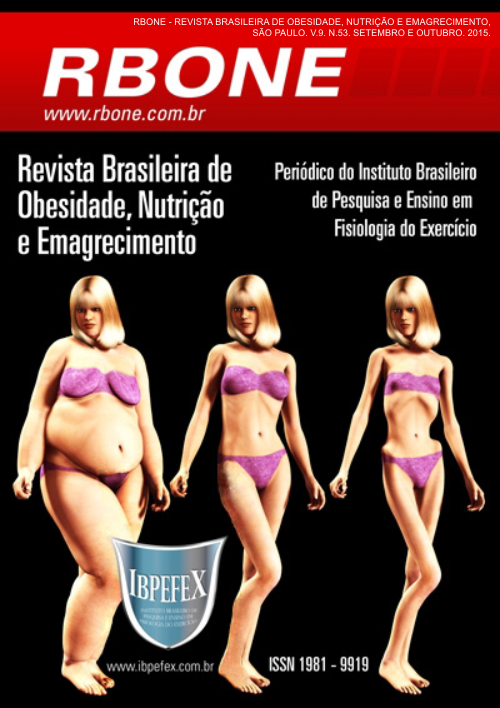The prevalence of overweight and obesity in children from a school in the city of Rio Branco-AC and the importance of schoolar physical education of this epidemic
Abstract
Introduction: Obesity is considered a public health problem that can be started at any ages and is characterized as a disease of multifactorial origins. Changes in eating habits and sedentary life habits are contributing factors to the individuals becoming obese. Physical education in school is fully capable of creating strategies to encourage healthy habits in students, as a subject of great acceptance in school. Aim: This study aimed to evaluated the anthropometric data from students with overweight and obesity and create a relation between the roles of the physical education teacher facing the data collected. Materials and Methods: 419 students between the age group 11-13 years were evaluated. Anthropometric data (height, weight) for calculating BMI, considered one of the most objective methods of nutritional assessment were collected. Result and Discussion: Based on BMI calculations it is possible identify that the school has a significant number of overweight and obese students, and the incidence is higher in male students. Conclusion: Through this analysis highlights the importance of school physical education teachers to develop teaching mechanisms that mitigate this current framework, encouraging students to adopt astyle more active life.
References
-Alves, F.M.; e colaboradores. Reducing obesity and related chronic disease risk in children and youth: a synthesis of evidence with ‘best practice’ recommendations. Núm. 7. p. 7-66. 2006.
-Barros Neto, T. Exercício, Saúde e Desempenho Físico. Editora Atheneu. 1997.
-Brasil. Ministério da Educação. Secretaria de Educação Fundamental. Parâmetros Curriculares Nacionais. Tema Transversal Saúde. Brasília. MEC/SEF. 1998.
-Cardin, L.; e colaboradores. Physical activity, energy expenditure and fitness: an evolutionary perspective.Int. J. Sports Med. Núm. 19. p. 328-335. 1998.
-Coutinho, W. Etiologia da obesidade. Revista ABESO. 2007. n. 7. p. 1-14. 2007.
-Darido, S. C.; Rangel, I. C. A. Educação Física na escola: implicações para a prática pedagógica. Guanabara Koogan. 2005.
-Fisberg, M.; Oliveira, C. L. Obesidade na infância e adolescência: Uma verdadeira epidemia. Arquivos Brasileiros de Endocrinologia e Metabologia. Núm. 2. Vol. 47. 2003.
-Guedes, D.P.; Guedes, J.E.R.P. Educação física escolar: uma proposta de promoção da saúde. APEF. Vol. 7. Núm. 14. p. 18. 1993.
-Leão, L.S.C.S.; e colaboradores. Prevalência de obesidade em escolares de Salvador, Bahia. Arquivos Brasileiros de Endocrinologia e Metabologia. Vol. 47. Núm. 2. p. 151-7. 2003.
-Matsudo, S.M.; Matsudo, V.K.R. Atividade física e obesidade: prevenção e tratamento. São Paulo. Atheneu. 2007.
-Nahas, M.V. Atividade Física e Qualidade de Vida. Núcleo de Pesquisas em Atividade Física & Saúde. UFSC. 1997.
-Organização Mundial de Saúde. Physical Status: The use and interpretation of anthropometry. Genebra. 1995.
-Organização Mundial de Saúde. Obesidade: prevenindo e controlando a epidemia global. Relatório OMS. Genebra. 1997.
-Ronque, E.R.V. Prevalência de sobrepeso e obesidade em escolares de alto nível socioeconômico em Londrina, Paraná, Brasil. Revista Nutr. Vol. 18. Núm. 16. 2005.
-Yagui, C. M. Criança obesa, adulto hipertenso. Revista Eletrônica de Enfermagem. 2011.
Authors who publish in this journal agree to the following terms:
- Authors retain the copyright and grant the journal the right of first publication, with work simultaneously licensed under the Creative Commons Attribution License BY-NC which allows the sharing of the work with acknowledgment of the authorship of the work and initial publication in this journal.
- Authors are authorized to enter into additional contracts separately for non-exclusive distribution of the version of the work published in this journal (eg, publishing in institutional repository or book chapter), with acknowledgment of authorship and initial publication in this journal.
- Authors are allowed and encouraged to post and distribute their work online (eg, in institutional repositories or on their personal page) at any point before or during the editorial process, as this can bring about productive change as well as increase impact and impact. citation of published work (See The Effect of Free Access).






